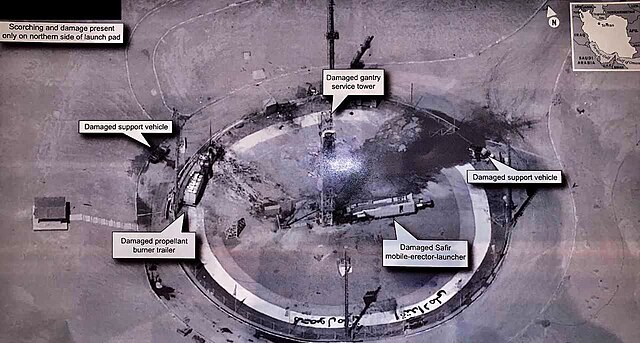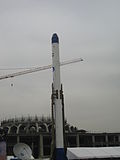Top Qs
Timeline
Chat
Perspective
Safir (rocket)
Iranian satellite rocket From Wikipedia, the free encyclopedia
Remove ads
The Safir (Persian: سفیر, meaning "ambassador") was the first Iranian expendable launch vehicle able to place a satellite in orbit.[1] The first successful orbital launch using the Safir launch system took place on 2 February 2009 when a Safir carrier rocket placed the Omid satellite into an orbit with a 245.2 km (152.4 mi) apogee.[2][3] This made Iran the ninth nation capable of producing and launching a satellite.[4]
The Simorgh is a larger orbital launcher based on Safir technology which has since replaced the Safir, and is sometimes called the Safir-2.[5]
Remove ads
Design and specifications
The Safir measures 1.25 meters in diameter, 22 meters in height and has a launching mass of 26 tons. The rocket consists of two stages; The first stage utilizes an upgraded Nodong/Shahab-3 type engine which burns a hypergolic combination of UDMH as fuel and nitrogen tetroxide as oxidant, producing 37 tons (363 kN; 82,500 lbf) of thrust. The second stage utilizes a pair of smaller gimballed engines called LRE-4, fed by a common turbopump (originally the Vernier engines of the R-27 Zyb Soviet SLBM[6]) burning the same fuel combination as the first stage and producing 3.5 tons (35 kN; 7700 lbf) of thrust. This configuration gives Safir the ability to inject a payload with a maximum weight of 50 kilograms into low Earth orbit.[7]
Remove ads
Variants
Summarize
Perspective
Kavoshgar-1
Kavoshgar-1 (Persian: کاوشگر ۱, "Explorer-1") was Safir's precursor used as a sounding rocket, a sub-orbital flight was conducted on 4 February 2008, as announced by state-run television. A launch on 25 February 2007 may also have been of the same type. The flight carried instruments to measure the higher atmosphere. The rocket launched on 4 February 2008 was a liquid-propellant-driven rocket, a derivative of the Shahab-3, that reached an altitude of 200–250 km in space, and successfully returned science data according to the Iranian News Agency.[8][9]
On 19 February 2008, Iran offered new information about the rocket and announced that Kavoshgar-1 used a two staged rocket. The first stage separated after 100 seconds and returned to earth with the help of a parachute. The second stage continued its ascent to an altitude of 200 kilometers.[10]
Safir-1A
The Safir-1A is the first upgraded variant of the original Safir, these upgrades include, refinement of the second stage retro-rockets, stage separation systems, various sensors and telemetry systems, navigation and control systems, as well as increasing maximum orbit height from 250 to 275 kilometers.[11][12]
Safir-1B
The Safir-1B is a further upgrade of the Safir-1A design, the first-stage engine has been upgraded and refined, resulting in an increase in thrust from 32 to 37 tons (363 kN; 82,500 lbf), the second stage engine has been upgraded with thrust vector control capability and has been made more efficient. These upgrades have increased payload capability to 50 kilograms, and have increased maximum orbit height to 400 kilometers.[7][12]
Remove ads
Retirement
During the unveiling ceremony of the Zuljanah satellite launch vehicle on the state TV, Seyed Ahmad Husseini, the spokesman of the Ministry of Defense's Aerospace Organization stated that the Safir launch vehicle is in a state of retirement and no further launches are planned with this vehicle.[13][14][15]
Launch history
Summarize
Perspective

Safir made eight launches in its operational career, putting four satellites into orbit.

Remove ads
Gallery
- 2012 launch of navid satellite
- Safir at an exhibition at the Mosalla of Tehran
- Safir first-stage engine
See also
Other Iranian satellite launch vehicles
References
External links
Wikiwand - on
Seamless Wikipedia browsing. On steroids.
Remove ads




